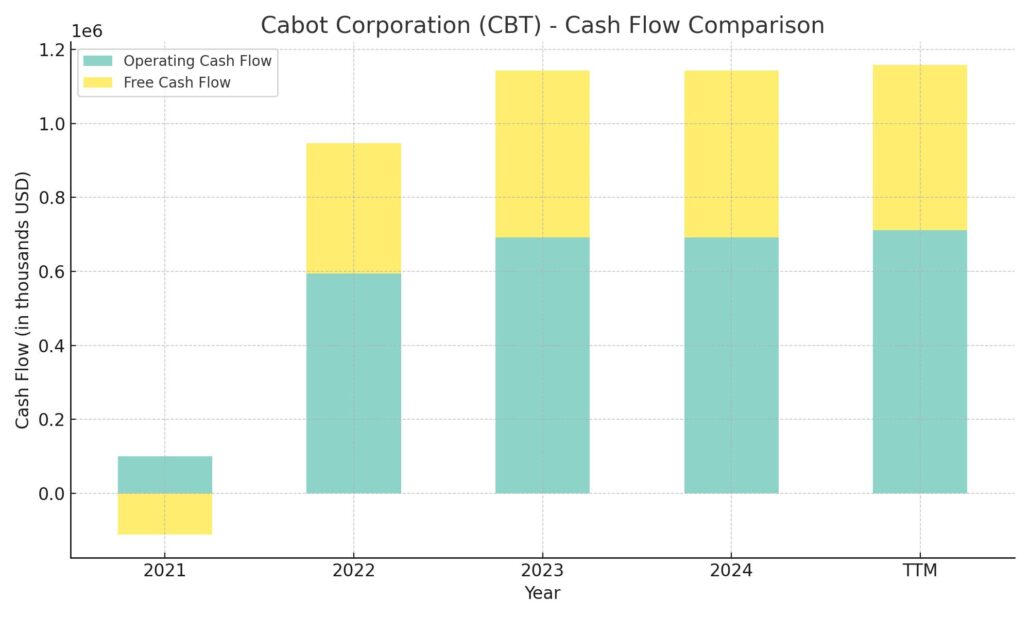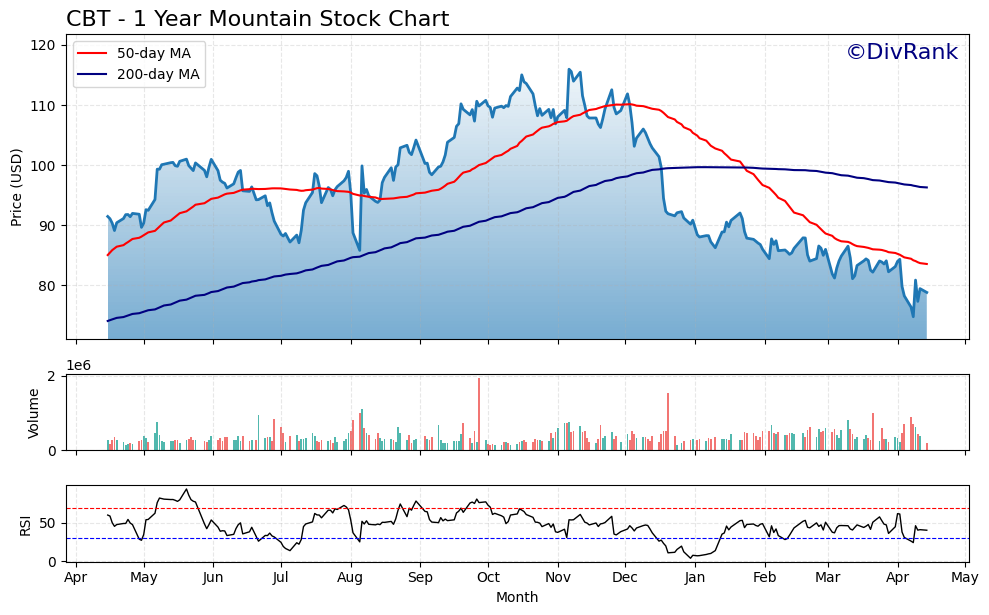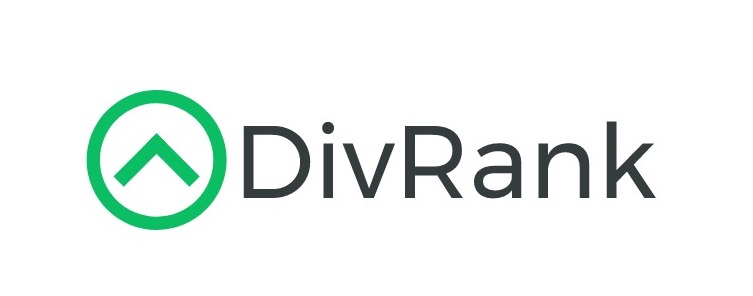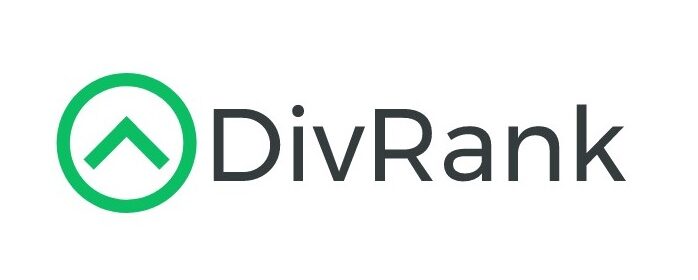Updated 4/14/25
Cabot Corporation (CBT) operates in the specialty chemicals space, supplying critical materials used in performance and reinforcement applications, including tire manufacturing, battery materials, and specialty carbons. With a global footprint and a consistent approach to capital allocation, the company combines steady cash flow with disciplined growth investments. Over the past year, Cabot has delivered solid earnings, maintained a strong balance sheet, and continued returning capital to shareholders through dividends and buybacks. Recent quarterly results showed a 13% increase in adjusted EPS and robust performance in its Performance Chemicals segment. Though the stock has pulled back from its highs, Cabot trades at a reasonable valuation and continues to generate reliable free cash flow. Leadership has reaffirmed earnings guidance and outlined long-term priorities focused on innovation, sustainability, and shareholder value. For investors focused on income and long-term operational strength, the company offers a well-rounded story.
🔍 Recent Events
The most recent quarterly results show a company making the most of its efficiency. Net income jumped 86% year-over-year, a healthy uptick that stood out even though top-line revenue dipped slightly, down 0.3%. This suggests Cabot is squeezing more value out of each dollar, rather than growing by volume—always a welcome trait during slowdowns or market turbulence.
The stock itself hasn’t had the easiest ride lately, dropping roughly 15% over the past year. From its 52-week high near $117, shares have slid down to about $79. That kind of pullback might raise an eyebrow, but if you’re focused on the income side of things, it might also present an opportunity. The fundamentals haven’t broken down. In fact, Cabot’s return on equity stands tall at over 31%, and return on assets is over 11%. These numbers reflect a business with real financial strength.
Debt is part of the mix—about $1.2 billion on the books—but it’s not weighing the company down. With a current ratio of 2.0 and free cash flow running strong, Cabot’s balance sheet looks capable of supporting both operations and shareholder returns.
📊 Key Dividend Metrics
💸 Forward Dividend Yield: 2.16%
🔁 5-Year Average Yield: 2.37%
📆 Ex-Dividend Date: February 28, 2025
💵 Dividend Payout Ratio: 22.5%
📈 Dividend Growth: Consistent, measured increases
🛡️ Dividend Safety: High, supported by solid free cash flow
🧾 Levered Free Cash Flow (TTM): $396 million
📉 Stock Performance (52-Week): -14.61%
🏦 Next Pay Date: March 14, 2025
💰 Dividend Overview
Cabot’s current yield of just over 2% might not raise any pulses for high-yield chasers, but don’t overlook its importance for a long-haul portfolio. The company’s forward dividend of $1.72 per share is comfortably backed by earnings, with a payout ratio sitting below 23%. That’s well within the “safe zone” and signals a management team that understands how to balance shareholder rewards with future investment.
One of the standout aspects here is just how steady the dividend policy has been. No wild swings. No sudden freezes or cuts. Just deliberate, consistent cash returns to shareholders—quarter after quarter. That alone is valuable when you’re building a portfolio for durability.
Ownership is overwhelmingly institutional, with more than 99% of shares held by large investors. The average volume hovers around 460,000 shares, and while there’s a bit of short interest (roughly 6.6% of the float), it’s not enough to change the fundamental dividend story.
🌱 Dividend Growth and Safety
Cabot doesn’t try to impress with double-digit dividend growth, and that’s perfectly okay. What it does offer is a high level of predictability. The company’s cash flows—over $700 million in operating cash in the last twelve months—easily cover its dividend needs. Free cash flow alone nearly quadruples the annual dividend cost, leaving a lot of breathing room.
That’s the kind of margin dividend investors love to see. In tougher years, Cabot can continue paying its dividend without strain. In stronger years, there’s room to increase the payout, retire debt, or invest in new opportunities.
Debt levels are on the higher side, with a debt-to-equity ratio near 79%, but it’s being managed well. With interest rates still elevated, the company’s ability to produce reliable free cash flow gives it flexibility to handle repayments and keep its dividend intact.
And while the recent earnings growth was eye-catching, what matters more is that Cabot doesn’t need huge earnings gains to support its dividend. Even modest profit levels provide ample coverage thanks to disciplined financial controls.
For investors looking for a quietly capable dividend payer, Cabot Corporation delivers. It doesn’t try to be more than it is, and in a world of hype and volatility, that kind of steady hand is easy to appreciate.
Cash Flow Statement
Cabot Corporation’s trailing twelve-month (TTM) cash flow profile highlights a business generating strong operational results while maintaining disciplined financial management. Operating cash flow reached $711 million, continuing a multi-year climb from $595 million in 2022 and $692 million in 2023. This upward trend reflects both improved margins and tighter working capital management, which has helped drive consistently high levels of free cash flow—$447 million over the past 12 months.

The company has continued to invest in its long-term growth, with capital expenditures at $264 million in the TTM period. Financing cash flow remained negative, at -$410 million, driven by ongoing debt repayments and share repurchases. Debt paydown totaled $158 million while Cabot also returned $181 million to shareholders through buybacks. Despite these outflows, the company’s cash position improved to $260 million at the end of the period. That kind of balance between reinvestment, debt management, and shareholder returns speaks to solid capital allocation discipline—critical for sustaining a dividend strategy over time.
Analyst Ratings
📉 Cabot Corporation has experienced a few notable analyst rating changes recently, reflecting a more cautious tone from some firms as macroeconomic conditions continue to shift. Back in November 2024, JPMorgan downgraded the stock from neutral to underweight. The rationale centered around concerns tied to margin pressures and a potential dip in demand across some of Cabot’s key industrial end markets. Alongside the downgrade, the price target was trimmed from $105 to $85, suggesting a pullback in near-term expectations.
🟢 Meanwhile, not all analysts have turned bearish. In January 2025, Mizuho maintained its buy rating, albeit with a slightly reduced price target of $110, down from $122. The firm still sees solid long-term value in Cabot’s specialty chemicals segment, though it did acknowledge the near-term softness that’s likely to weigh on earnings. Their optimism was rooted in the company’s stable cash generation and disciplined capital deployment.
⚖️ UBS took a more balanced view in April 2025, keeping its neutral rating intact but revising its target from $93 to $83. This adjustment reflects a more tempered outlook as UBS factors in ongoing cost pressures and a muted global manufacturing backdrop that may limit upside momentum.
🎯 As of now, the consensus analyst rating on Cabot Corporation is hold, with an average price target of approximately $93.25. This reflects a modest potential upside from current levels and suggests that while analysts don’t foresee explosive growth ahead, they recognize the company’s steady fundamentals and reliable cash flow.
Earning Report Summary
Cabot Corporation got off to a strong start in fiscal 2025, putting up results that showed steady momentum despite a mixed industrial backdrop. The company reported adjusted earnings per share of $1.76 for the quarter, which was up 13% from the same quarter a year ago. That kind of year-over-year bump speaks to some underlying strength in their operations, particularly in their Performance Chemicals business.
Performance Chemicals Drives the Quarter
The standout segment this time around was Performance Chemicals. EBIT for that part of the business jumped 32% year-over-year, thanks mostly to increased volumes. Demand held up better than expected in key areas like specialty carbons and battery materials. It’s clear Cabot is starting to see some benefits from investments made over the past couple of years to build out its capabilities in higher-margin, innovation-driven categories.
Reinforcement Materials a Mixed Bag
The Reinforcement Materials segment was a bit of a mixed story. Sales slipped by nearly 5%, which raised some eyebrows. But interestingly, segment EBIT still came in slightly higher than the year prior. Management pointed to stronger volumes and more favorable pricing dynamics in certain regions, which helped offset the revenue dip. It’s not perfect, but it shows resilience in a business that’s often tied closely to global economic swings.
Cabot also continued its trend of solid cash generation. Operating cash flow hit $124 million for the quarter, providing plenty of breathing room to invest in the business while also rewarding shareholders. Over $66 million was returned through a mix of dividends and stock buybacks—something long-term investors always like to see.
Leadership Commentary and Outlook
Leadership sounded cautiously optimistic about the rest of the year. They reaffirmed their full-year adjusted EPS guidance in the range of $7.40 to $7.80, pointing to continued strength in core segments and disciplined cost control. Management emphasized that while macro conditions are still uncertain, they believe their balanced portfolio and recent strategic moves put them in a good spot to weather any short-term bumps.
Looking ahead, the tone was one of controlled confidence. The company plans to keep focusing on specialty product lines and driving growth in areas like battery applications and performance additives. It’s clear they’re not just trying to protect margins—they’re also laying the groundwork for long-term expansion. For dividend investors or those watching cash flows closely, this quarter offered a reassuring snapshot of a company managing both growth and stability.
Chart Analysis

The past year has been a bit of a journey for CBT, with the price carving out a notable high near $115 in November before entering a steady downtrend. The visual tells a clear story: after a strong climb through the summer and early fall, the stock began to roll over as momentum faded and selling pressure crept in.
Moving Averages
One of the most striking features on this chart is the crossover between the 50-day and 200-day moving averages. Around December, the 50-day moving average (shown in red) crossed below the 200-day (in blue), a classic signal that momentum has shifted to the downside. Since then, the shorter-term average has remained below, and both lines are now sloping lower, suggesting that the recent trend remains bearish. For those watching long-term price trends, this kind of setup usually signals a cooling period where the stock consolidates or continues drifting lower unless there’s a shift in sentiment.
Volume Behavior
Volume remained relatively steady through most of the chart, but there were some spikes during sharp sell-offs, especially in December and again in March. That kind of action often hints at institutional activity—either trimming exposure or adjusting positions. Recently, volume has picked up again as the price tests lower levels, possibly indicating that a base could be forming as buying interest starts to return at more attractive levels.
Relative Strength Index (RSI)
Looking at the RSI at the bottom of the chart, you can see that CBT has spent considerable time below the neutral 50 line since early January, with dips close to oversold territory on multiple occasions. While it hasn’t firmly broken below the 30 mark in recent weeks, it’s hovered near those levels, suggesting the stock has been under some persistent pressure but may also be near exhaustion in the short term. At these levels, momentum appears stretched on the downside, often a point where prices begin to stabilize or reverse if broader support kicks in.
Price Trend and Current Levels
The price is now sitting in the upper $70s to low $80s range, just above its 52-week low. There’s no clear breakout attempt yet, but it does look like the stock is trying to find its footing. The fact that the price hasn’t broken significantly lower despite sustained selling pressure could indicate that a potential bottom is forming, especially with RSI and volume aligning for a possible shift in tone.
For those watching this name closely, the next few weeks could be telling. A move back above the 50-day average would be an early technical signal that confidence is returning, though it would need to be backed by stronger volume and consistent buying pressure to be meaningful. Until then, the chart reflects a stock in transition—one that has come off its highs and may now be exploring its next direction.
Management Team
Cabot Corporation is led by a deeply experienced executive team that brings a long track record in specialty chemicals and industrial materials. At the top is Sean Keohane, who has served as President and CEO since 2016. Keohane joined the company back in 2002 and has held key leadership roles across the organization, including President of the Performance Chemicals and Reinforcement Materials segments. His background includes management experience with global companies in manufacturing and technology, which has helped shape Cabot’s strategic direction.
Supporting him is Erica McLaughlin, who serves as Executive Vice President, Chief Financial Officer, and Head of Corporate Strategy. She’s been with Cabot for over two decades and has rotated through a range of business and finance roles. Her insights into both the operational and strategic sides of the business give her a unique edge in guiding financial planning and execution.
The broader team includes Patricia Hubbard, Chief Technology Officer, who oversees innovation across material science and product development. Aaron Johnson brings extensive expertise to the company’s engineering, supply chain, and operations, while Bart Kalkstein leads the Reinforcement Materials segment and Cabot’s Americas region. Together, the team combines deep sector knowledge with an ability to adapt to market shifts and long-term industry trends.
Valuation and Stock Performance
Cabot’s stock has moved through a range of environments over the past year. Currently trading around the low $90s, shares have rebounded off recent lows but still remain below the highs seen near $117. The stock’s 52-week range has been wide, reflecting both broader macro pressures and sector-specific shifts in demand.
From a valuation standpoint, Cabot trades at a price-to-earnings ratio in the low teens, which signals a relatively modest valuation considering the strength of its earnings and cash flow. The company’s price-to-book ratio sits just over 3, while the price-to-sales ratio is slightly above 1. Those numbers are fairly typical for firms operating in the specialty chemicals space, where stable revenues and high asset efficiency are often rewarded with a valuation premium.
The market is currently assigning a consensus price target just above current levels, hovering around $93. Most analyst ratings fall in the hold category, which makes sense in a year when growth is expected to be steady but not explosive. Still, Cabot’s recent results have shown continued operational discipline and margin strength, especially in its Performance Chemicals segment.
Over the last year, earnings growth has been impressive, with adjusted EPS climbing over 30%. That kind of growth isn’t always common in a mature industrial business, and it’s come alongside healthy cash generation. Operating cash flow came in strong, which supported both reinvestment and consistent shareholder returns through dividends and buybacks.
Risks and Considerations
No stock is without risk, and Cabot is no exception. The business is sensitive to global economic cycles, particularly in sectors like automotive and infrastructure where its materials play a large role. When industrial demand softens, revenue can come under pressure, and even though the company has done a good job protecting margins, top-line softness could eventually weigh on earnings.
Raw material volatility is another factor. Feedstock pricing for carbon black, for example, can shift quickly, putting pressure on cost structures. Though Cabot typically passes these costs along to customers, there can be lags and volatility in the process that squeeze near-term profitability.
Global operations add another layer of complexity. Currency fluctuations, geopolitical instability, and changing trade regulations can all impact performance. The company also faces ongoing regulatory scrutiny around emissions and environmental standards, which could require additional investment to stay compliant.
Then there’s competition. Cabot operates in a space where differentiation is possible through innovation, but pricing pressures are always a consideration. Staying ahead with new products and applications is essential to protecting market share and sustaining margins.
Finally, while the company maintains a solid balance sheet, interest rate exposure and refinancing risks are worth keeping on the radar, especially as capital spending remains elevated in areas like battery materials and innovation pipelines.
Final Thoughts
Cabot Corporation has positioned itself well to navigate both today’s challenges and tomorrow’s opportunities. The leadership team has shown they can execute across various market cycles, and their commitment to driving innovation while maintaining financial discipline gives the company a strong foundation.
Valuation remains reasonable, especially given the consistency in earnings and free cash flow. For investors watching long-term return potential, that combination of steady income, operational focus, and manageable risk is compelling.
Risks do exist, especially from macro and regulatory angles, but Cabot has built in enough flexibility and strategic direction to manage through near-term disruptions. As the company continues to invest in high-growth areas and prioritize shareholder value, its ability to deliver both performance and resilience will likely stay in focus. The road ahead may not be linear, but the groundwork has been laid for sustainable growth.

